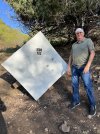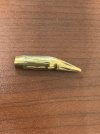You didn't talk to someone at Leupold that knows. The TLR is indeed a Leupold factory built scope exclusively for Thompson Long Range in Logan Utah. He has them in stock and mine came in a Leupold factory box labeled with a Leupold label that includes a picture of the reticle. I also talked with Leupold at the shot show and asked them about it, they told me like they told you that they didn't make any custom reticles so I can see where you were misinformed. Only when I told them that I knew for a fact that they did, then the truth came out.
I went to the Thompson Long Range Class and assembled the scope on a brand new Weatherby Mark 5 chambered in 30-378 Weatherby, bore sighted it, shot two shots at 300 yards, one shot at 500 yards, one shot at 700 yards and then a 3 shot group that was under one MOA at 1000 yards. Then cranked toe power down to 12 X and shot one shot at 1200 yards on a 8X10 steel plate and made a solid hit on it. Notice the group is right of center, that is because I held center with no allowance for wind. Also note those three shots are shots number 5, 6, 7, from a brand new gun with no break in. This was using the 1000 yard dot.
Mark has put over 4000 students with this system through his class and has no failures, and even though he offers a money back guarantee he has had no one dissatisfied.
Like I said, previously, I have many high end scopes with turrets and fully understand how to use them but prefer the simplicity of this system.
I'm curious with what you mean by here we go again?
Well all that could have been mentioned in your first post, couldnt it?
None the less, there are still things not said.
Like the ammo for example.
The reticle will only work (properly) with the specific ammo you used.
Which was no doubt supplied/sold by the school, along with the scope, and maybe the gun ?
Otherwise it wouldnt have worked properly.
As for turning the power down in order to hit the 1200 target, somebody did alot of experimenting in order to find that out didnt they?
Is that something average Joe hunter might do when he is out Elk hunting?
So now lets go to say 1450, what power do you use for that?
Did they tell you that you could also use the dial?
Does the scope even have a dial?
Maybe the school only sells the scopes, in order to sell people on the school ? lol
Like the carrot on the string.
You really really want to do this dont you ?
Well come join us, and you too can show all your friends how its done.
But they gotta come here first if they want the scope. lol
Back in those deep dark hollows of NC PA, nobody went to school. Any kind of school. lol
As for the 30x378, i used one for long range hunting for about 25 years.
Built by a man who lived in one of those hollows.
He wouldnt build me the gun untill i had the right powder to use in it. Which at the time wasent easy to come by.
A heavy bench type gun, custom action, 36" 1"250 barrel,
3500 FPS with a 200 gr SMK, using 113 gr H570.
The H isnt a typo.
The man in the hollow told me what to load, and he gave me a click chart.
I used a B & L Balvar 6x24 power scope with a Kuharsky micrometer rear mount on it.
Today the gun has a new barrel, chambered in a better cartridge.
And it wears a new Nightforce scope, which i frankly dont consider as an improvement for what i use it for.
The old Leupold scopes with the Premier reticles are used on lighter 7x300 Wetherbys. Guess who built them. lol
The reticles were set up for the 162 gr Hornady BTHP bullet at 3350 FPS.
I used one of them to kill my first and only PA black bear with a first round hit on a 700 + yard shot.
The only luck part was seeing the bear. lol


